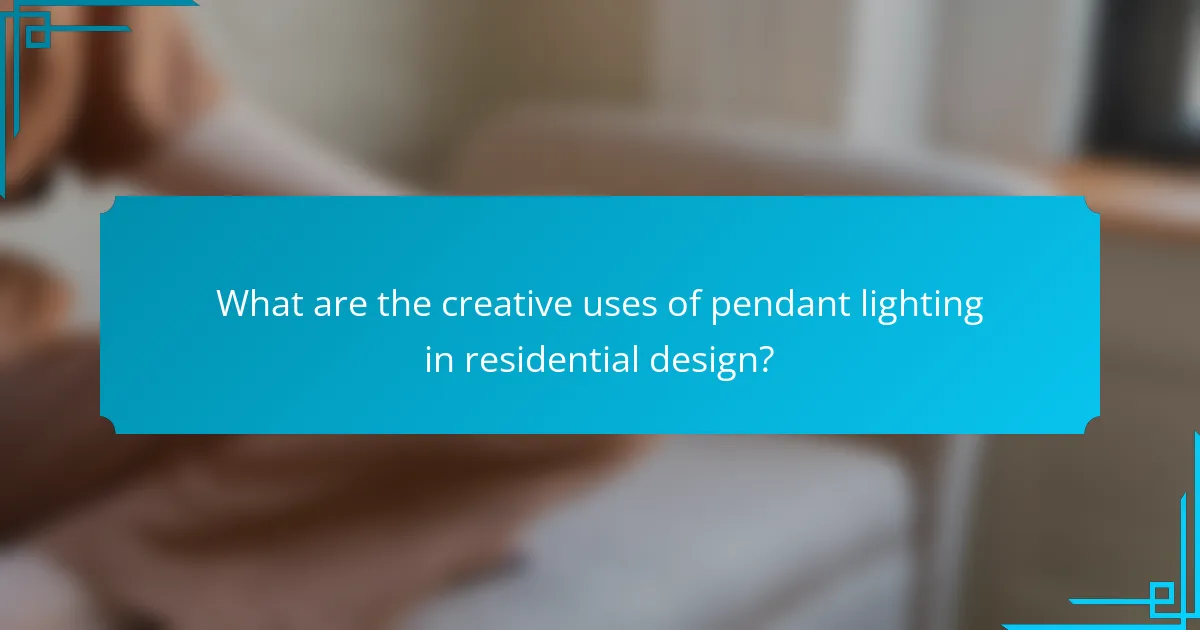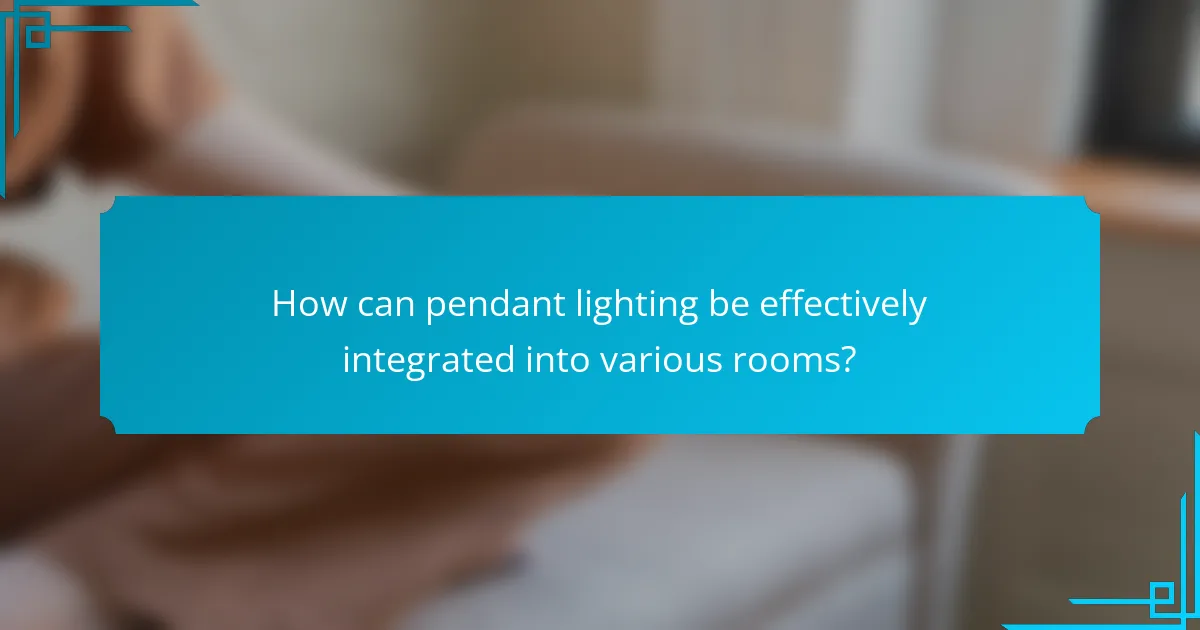Pendant lighting is a versatile element in residential design, serving multiple functions such as focal points, task lighting, and ambiance creation. It enhances spaces by providing direct illumination over kitchen islands and dining tables while contributing to a cozy atmosphere in living areas. The design of pendant lights can also delineate areas in open floor plans, with various styles reflecting personal taste and enhancing overall aesthetics. Current trends include the use of sustainable materials, bold geometric shapes, and smart technology integration, showcasing a blend of functionality and style that caters to modern design preferences.

What are the creative uses of pendant lighting in residential design?
Pendant lighting serves various creative purposes in residential design. It can act as a focal point in a room. For instance, a large, decorative pendant can enhance the aesthetic of a dining area. Pendant lights can also be used for task lighting. They provide direct illumination over kitchen islands or workspaces. Additionally, they can create ambiance in living spaces. Soft, warm pendant lights contribute to a cozy atmosphere.
Moreover, pendant lighting can define spaces within open floor plans. Different styles can distinguish the dining area from the living area. Layering pendant lights with other lighting sources adds depth to the design. This approach enhances the overall visual interest in a room. Finally, pendant lighting can be customized to fit personal styles. Unique designs can reflect the homeowner’s taste and personality.
How does pendant lighting enhance the overall aesthetic of a space?
Pendant lighting enhances the overall aesthetic of a space by providing focused illumination and adding decorative elements. It serves as a statement piece, drawing attention to specific areas like dining tables or kitchen islands. The variety of designs, materials, and colors available allows for personalization and complements existing decor. Pendant lights can create a warm ambiance, influencing the mood of the room. Furthermore, they can be used to highlight architectural features, enhancing the visual interest of a space. Studies show that well-placed lighting can significantly impact the perceived size and functionality of a room.
What design styles benefit most from pendant lighting?
Pendant lighting benefits most from modern, industrial, and farmhouse design styles. Modern design utilizes sleek lines and minimalist aesthetics, enhancing the space with pendant fixtures. Industrial design embraces raw materials and exposed elements, making pendant lights a perfect fit for their rugged charm. Farmhouse design combines rustic and cozy elements, with pendant lighting adding warmth and character. These styles often incorporate pendant lighting as a focal point, creating visual interest and functional illumination. The versatility of pendant lighting allows it to complement various color palettes and materials found in these design styles.
How can pendant lighting be used to create focal points in a room?
Pendant lighting can create focal points in a room by drawing attention to specific areas. These fixtures can be strategically placed above dining tables, kitchen islands, or seating areas. The downward illumination highlights these spaces, making them visually distinct. Pendant lights come in various designs, colors, and sizes, allowing for personalization. Unique shapes can also add artistic flair, enhancing the room’s overall aesthetic. Additionally, varying heights of pendant lights can create depth and interest. According to the American Lighting Association, proper placement of pendant lighting can significantly enhance a room’s ambiance. This emphasizes the importance of thoughtful design in residential spaces.
What practical benefits does pendant lighting provide in residential spaces?
Pendant lighting enhances the functionality and aesthetics of residential spaces. It provides targeted illumination, making it ideal for tasks like reading or cooking. This focused light improves visibility in specific areas. Pendant lighting also adds a decorative element to the room. It comes in various styles, colors, and materials, allowing for personalized design choices. Additionally, pendant lights can create a sense of ambiance. They can be dimmed to suit different moods or activities. Their height can be adjusted to fit various ceiling types, accommodating diverse room designs. Overall, pendant lighting effectively combines practicality with style in home environments.
How does pendant lighting improve functionality in different areas?
Pendant lighting enhances functionality by providing targeted illumination in various spaces. In kitchens, it offers focused light for cooking and food preparation. In dining areas, it creates an inviting atmosphere while ensuring visibility on dining tables. In living rooms, pendant lights can highlight specific areas, such as reading nooks or artwork. They also contribute to layered lighting, combining ambient and task lighting effectively. The adjustable height of pendant fixtures allows customization for different ceiling heights and room layouts. This versatility makes pendant lighting suitable for both aesthetic and practical purposes. Research indicates that well-placed pendant lighting can improve overall room usability and comfort.
What energy efficiency options are available with pendant lighting?
Energy efficiency options for pendant lighting include LED bulbs, dimmers, and smart lighting systems. LED bulbs consume up to 75% less energy than traditional incandescent bulbs. They also have a longer lifespan, lasting up to 25,000 hours. Dimmers allow users to adjust brightness, reducing energy consumption when full brightness is not needed. Smart lighting systems can automate schedules and adjust brightness based on natural light availability. These options contribute to lower energy bills and a reduced carbon footprint.

How can pendant lighting be effectively integrated into various rooms?
Pendant lighting can be effectively integrated into various rooms by considering the room’s purpose and design aesthetics. In kitchens, pendant lights can be hung above islands to provide task lighting. In dining areas, they can serve as a focal point above the table, enhancing the dining experience. In living rooms, pendant lights can add ambient lighting and complement existing decor. In bedrooms, they can be used as bedside lighting, offering both style and functionality. The height of the pendants should be adjustable to suit the specific room’s dimensions and ceiling height. Choosing the right style and finish can also tie the lighting into the overall design theme of the room. For instance, industrial-style pendants can enhance a modern decor, while vintage designs can add warmth to a traditional space.
What are the best practices for using pendant lighting in kitchens?
The best practices for using pendant lighting in kitchens include ensuring proper height placement. Pendant lights should hang 30 to 36 inches above the countertop. This height provides adequate illumination without obstructing views.
Choosing the right size is also crucial. Larger pendants work well over islands, while smaller ones suit dining areas. Using multiple pendants can create a balanced look and enhance lighting coverage.
Selecting the appropriate style and finish is important for aesthetic coherence. Match pendant designs with kitchen decor for a unified appearance.
Finally, consider dimmable options for versatility. Dimming allows for different lighting moods during cooking and entertaining. Following these practices ensures both functionality and style in kitchen lighting.
How does pendant lighting influence the kitchen’s workflow?
Pendant lighting enhances the kitchen’s workflow by providing focused illumination over work areas. This targeted light improves visibility for tasks such as chopping, cooking, and cleaning. Proper lighting reduces the risk of accidents and mistakes in food preparation. Pendant lights can also create a visual hierarchy, guiding the user’s attention to essential areas. Studies show that well-lit environments can increase productivity by up to 20%. This makes pendant lighting a valuable asset in kitchen design. Overall, the strategic placement of pendant lights contributes to a more efficient and enjoyable cooking experience.
What types of pendant fixtures work best in a kitchen setting?
Industrial pendant fixtures work best in a kitchen setting. These fixtures provide a modern and functional aesthetic. They often feature durable materials like metal or glass. Industrial designs typically showcase clean lines and minimalist styles. They can enhance task lighting over kitchen islands or dining areas. Adjustable height options allow for versatile placement. Pendant fixtures with multiple bulbs increase illumination. This combination of style and practicality makes them ideal for kitchens.
How can pendant lighting transform living areas?
Pendant lighting can significantly transform living areas by enhancing ambiance and functionality. This type of lighting serves as a focal point in design. It can draw attention to specific areas, such as dining tables or kitchen islands. Pendant lights come in various styles, shapes, and sizes, allowing for personalized decor.
They also provide task lighting, improving visibility for activities like reading or cooking. Adjustable heights can create intimacy or open up space, depending on the desired effect. Furthermore, pendant lighting can influence color perception and mood through different bulb types and shades.
According to the American Lighting Association, proper lighting can make spaces feel larger and more inviting. Thus, pendant lighting is a versatile tool in residential design that can enhance both aesthetics and usability.
What role does pendant lighting play in defining spaces within an open floor plan?
Pendant lighting serves to delineate spaces within an open floor plan. It creates visual boundaries that guide the eye and define functional areas. For instance, hanging a pendant light above a dining table establishes that space as distinct from the living area. This method enhances the organization of space without the need for physical barriers. Pendant lights also add layers of lighting, contributing to the overall ambiance. The height and design of the pendants can influence the perceived scale of the area. According to a study by the American Lighting Association, strategically placed lighting can improve spatial awareness and functionality in open layouts.
How can color and material choices in pendant lighting affect the ambiance of a living room?
Color and material choices in pendant lighting significantly influence the ambiance of a living room. Warm colors like amber or gold create a cozy and inviting atmosphere. Cool colors such as blue or silver can impart a calm and serene feeling. The material of the pendant also plays a crucial role. Metal fixtures often evoke a modern or industrial vibe. Glass materials can provide a more elegant or airy feel. Textured surfaces can add depth and interest to the space. For example, matte finishes reduce glare and create a softer light. In contrast, polished surfaces can enhance brightness and reflectiveness. Overall, thoughtful selection of color and material enhances the desired mood and character of the living room.

What are some innovative trends in pendant lighting design?
Innovative trends in pendant lighting design include the use of sustainable materials, bold geometric shapes, and smart technology integration. Sustainable materials such as recycled metals and eco-friendly glass are increasingly popular. Bold geometric shapes create visual interest and can serve as statement pieces. Smart technology integration allows for adjustable brightness and color temperature, enhancing functionality. Additionally, multi-pendant arrangements offer versatility in design and can suit various spaces. Trends also show a preference for minimalist aesthetics that focus on clean lines and simplicity. These trends reflect a growing emphasis on both functionality and style in residential design.
How are modern materials influencing pendant lighting styles?
Modern materials significantly influence pendant lighting styles by enabling innovative designs. Materials such as glass, metal, and sustainable composites allow for diverse shapes and finishes. For instance, glass can be molded into intricate forms, enhancing aesthetic appeal. Metal finishes, like brushed brass or matte black, provide a contemporary look. Sustainable materials, like bamboo or recycled plastics, appeal to eco-conscious consumers. These materials also affect light diffusion and intensity, creating varied atmospheres. The trend towards minimalism is reflected in the use of sleek, lightweight materials. Overall, modern materials expand creative possibilities in pendant lighting design.
What unique designs are emerging in pendant lighting for residential use?
Unique designs emerging in pendant lighting for residential use include geometric shapes, organic forms, and mixed materials. Geometric designs feature clean lines and angular silhouettes. These styles create a modern aesthetic in various spaces. Organic forms mimic natural shapes and add a soft touch to interiors. Mixed materials, such as combining metal and glass, enhance visual interest. Colorful pendant lights are also gaining popularity, allowing customization in decor. Minimalist designs focus on simplicity and functionality, appealing to modern sensibilities. Vintage-inspired styles blend nostalgia with contemporary elements, creating unique focal points. These trends reflect evolving tastes in residential lighting design.
How can technology enhance the functionality of pendant lighting?
Technology can enhance the functionality of pendant lighting through smart features and energy efficiency. Smart pendant lights can be controlled remotely via apps or voice commands. This allows users to adjust brightness and color temperature easily. Many smart options integrate with home automation systems for seamless use. Energy-efficient LED bulbs significantly reduce electricity consumption compared to traditional bulbs. These advancements can extend the lifespan of the lighting fixtures. Additionally, some pendant lights now feature sensors that adjust lighting based on ambient light levels. This ensures optimal illumination while conserving energy. Overall, technology transforms pendant lighting into versatile and efficient design elements.
What tips should homeowners consider when selecting pendant lighting?
Homeowners should consider the size, style, and placement of pendant lighting. The size should complement the room’s dimensions. A large pendant can overwhelm a small space. Conversely, a small pendant may get lost in a large room. Style should match the overall decor theme. For example, modern homes may benefit from sleek, minimalist designs. Placement is crucial for functionality and aesthetics. Hang pendants at eye level for optimal lighting. Additionally, consider the height of the ceiling. Higher ceilings may require longer pendant drops. Finally, think about the bulb type for desired brightness and ambiance. LED bulbs are energy-efficient and offer various color temperatures.
How do you determine the right size and scale for pendant lights?
To determine the right size and scale for pendant lights, measure the height and width of the space. A general guideline is to hang pendant lights 30 to 36 inches above surfaces like tables or islands. The diameter of the pendant should be about one-third the width of the surface below it. For larger spaces, consider multiple pendants to maintain proportionality. Additionally, the overall scale should complement the room’s dimensions and decor style. For instance, a large pendant can serve as a focal point in a spacious area.
What should be considered regarding installation height and placement?
Installation height and placement of pendant lighting should consider the room’s function and ceiling height. For dining areas, pendants should hang 30 to 36 inches above the table. In kitchens, they should be placed 28 to 34 inches above countertops. The height ensures adequate lighting while preventing obstruction. For spaces with high ceilings, consider using longer cords or multi-tiered fixtures. This maintains visual balance and enhances the room’s aesthetics. Additionally, the placement should align with furniture layout to avoid shadows and maximize light distribution.
Pendant lighting is a versatile element in residential design, serving various creative purposes such as enhancing aesthetics, providing task lighting, and defining spaces within open floor plans. This article explores the practical benefits of pendant lighting, including its role in improving functionality and ambiance in different areas of the home. It also discusses the best practices for integrating pendant lights into various rooms, innovative design trends, and the impact of technology on their functionality. Additionally, the article provides tips for homeowners on selecting the right size, style, and placement of pendant lighting to achieve optimal design and usability.